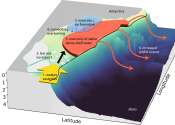Wind is a major driver of Antarctic deep water formation and the planet's ocean circulation, shows study
Earth's oceans are a complex system, and their interconnected nature has global implications. Around Antarctica, cold and dense waters form in the depths of the Southern Ocean. This is known as Antarctic Bottom Water (AABW). ...









